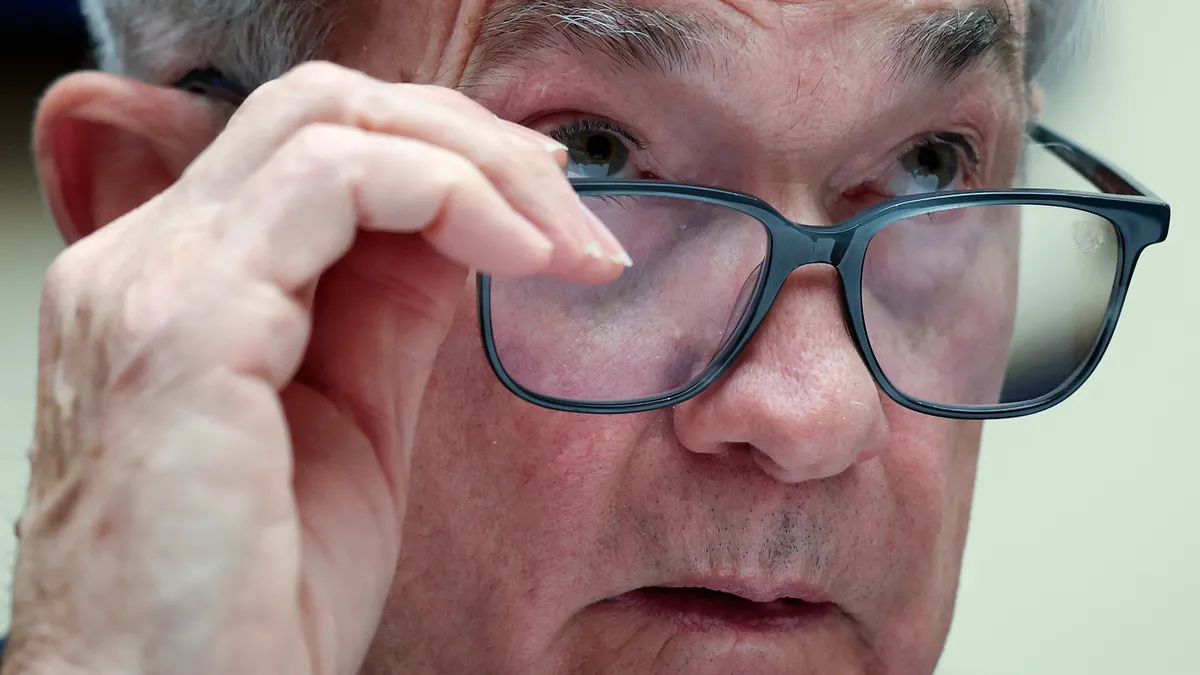Dive Brief:
-
Federal Reserve officials on Wednesday trimmed from three to one their median forecast for cuts to the main interest rate this year and affirmed their fight against inflation by holding borrowing costs at the two-decade high set last July.
-
Central bank officials marked up their median projections for the gain this year in the core personal consumption expenditures price index, excluding food and energy, to 2.8% from 2.6% in March. They see unemployment ending 2024 at 4%, no change from their median forecast in March, and the federal funds rate at 5.1% at year-end rather than their prior projection of 4.6%.
- “We do not expect it will be appropriate to reduce the target range for the federal funds rate until we have gained greater confidence that inflation is moving sustainably toward 2%,” Fed Chair Jerome Powell said during a press conference. “So far this year, the data have not given us that greater confidence,” he said, while noting measures of price pressure have declined since the first quarter.
Dive Insight:
The central bank’s unanimous decision came just a few hours after a report that the core consumer price index rose in May at an annual rate of 3.4%, less than economists predicted and the slowest pace since 2021.
Core CPI also fell in April, suggesting that a rebound of inflation during the first quarter may have been a blip on a disinflationary trajectory that began in mid-2023.
The inflation data “gives the Fed some breathing room to cut rates if growth continues to deteriorate,” AssetMark Chief Investment Officer Christian Chan said in an email before the Fed statement.
“Growth, particularly employment and manufacturing, has shown signs of slowing and consumers are showing signs of stress,” Chan said. “With both headline and core [inflation] numbers resuming their YOY declines, the Fed will be able to lower rates if growth should slow further.”
Since the end of their prior two-day meeting on May 1, Fed officials have said they need to see several months of inflation falling toward their target before beginning to trim the federal funds rate from a range between 5.25% and 5.5%.
Costs for imports, wages and non-housing services stand out as recent spurs to inflation, Powell said.
The core personal consumption expenditures price index, which excludes volatile food and energy prices, will slow to 2.3% next year and to the Fed’s 2% objective in 2026, according to the median projection by Fed officials.
In turn, the central bank will likely trim the main interest rate to 4.1% by the end of next year and to 3.1% by the end of 2026, according to the median forecast.
Inflation expectations, a measure closely tracked by Fed officials, have remained stable. Median inflation expectations in May for one-year ahead fell to 3.2% from 3.3% in April and were unchanged at the three-year horizon at 2.8%, the New York Fed said Monday.
Persistent strength in the labor market has clouded the outlook for rate cuts. Despite tight monetary policy, hiring has remained robust, with employers adding 272,000 jobs in May, the Labor Department reported Friday.
“The overall picture is one of a strong and gradually cooling, gradually rebalancing labor market,” Powell said, while noting that job openings still exceed the number of unemployed workers.
The unemployment rate will increase to 4.2% next year before falling to 4.1% in 2026, Fed officials said in their median forecast.
“Overall, we’re looking at what is still a very strong labor market but not the superheated labor market of two years ago or even one year ago,” Powell said.
The higher-than-anticipated gain in payrolls prompted the Atlanta Fed on Friday to raise its estimate for economic growth during the second quarter to a 3.1% annual rate from 2.7% the prior day. Unemployment, although edging up last month to 4% from 3.9% in April, has not exceeded 4% for 30 months.
CEOs during Q2 upgraded their forecast for growth this year to 2.3% from 2.1% during Q1, the Business Roundtable said Wednesday, describing results of a survey with 144 respondents.
“The overarching message from our member CEOs is that the economy is steady and stable, but they remain cautious,” Chuck Robbins, CEO of Cisco and Business Roundtable chair, said in a statement.
Powell singled out solid economic growth during the second half of 2023 as a positive surprise.
“We continue to see still-strong growth curves, solid growth, this year,” he said Wednesday, adding “it’s in sharp distinction with many other advanced economies around the world.”
Powell emphasized that policymakers face the risk of easing too soon, and of holding rates high for too long.
“We're well aware of the two-sided risks here,” Powell said. “We understand that if we wait too long, that could come at the cost of economic activity, of employment.”
“We understand that if we move too quickly, we could end up undoing a lot of the good that we've done, and have to then start over – and it could be very disruptive,” he said.












